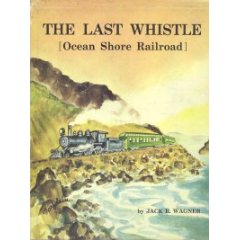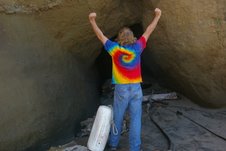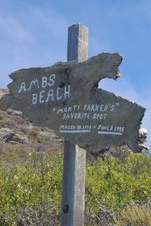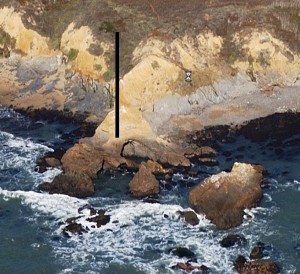Images/Story from John Vonderlin
Email John ([email protected])

HE SAN FRANCISCO CALL

Images/Story from John Vonderlin
Email John ([email protected])

HE SAN FRANCISCO CALL


 as well as the knowledge that Highway 1 now follows much of the railroad’s planned route, I assumed the Ocean Shore would have taken a straight shot down the hill, across the dunes, and over the creek bed to the solidity of the promontory to the south.
as well as the knowledge that Highway 1 now follows much of the railroad’s planned route, I assumed the Ocean Shore would have taken a straight shot down the hill, across the dunes, and over the creek bed to the solidity of the promontory to the south.

 John Vonderlin’s earlier posts about Monty Parker, please click here
John Vonderlin’s earlier posts about Monty Parker, please click here
Email John ([email protected])
Read the emails between South Coast explorers Larry Fitterer and John Vonderlin

Hi John,
I took my twins to the coast yesterday afternoon. We hiked down to Greyhound Rock and explored the surrounding tide pools. On the way back, I noticed a truck in the small turnout directly above the Monty Parker sign. We hiked down to the sign and found two ropes going over the edge. Off in the distance, toward Warm Water Lagoon, we saw two men and a dog building a fire.
I remembered the jar you left at the base of the sign and checked it. Someone left a note! I did not take the note, since the spot feels like a shrine, and I don’t have the contents committed to memory.
Here’s what I recall. Monty Parker was a long time resident of the area, an avid explorer, and abalone diver who drowned just off that spot while diving for abalone. He was a high school sports coach, and there is a sports field (Parker Field) named after him. The school name was abbreviated, and I don’t recall the initials.
I was sure the gentlemen down below were acquainted with Monty Parker, and I wanted to wait for them to ascend the rope. However, it was getting late and the kids were getting antsy. Instead, I left my business card on the windshield of the truck and invited them to call me to discuss Monty.
Several hours later, I received a call on my mobile phone. No message, but I’m pretty sure it was one of the climbers. I called back and left a message. I will let you know if/when I connect with them. Hopefully, they can unravel the Monty Parker mystery. Also, I would love to know how they got their dog down the cliff!
Hope all is well, and my best to Meg,
Larry
—————-

Thanks again for following through. Meg and I wish you and your family the happiest of Holidays and hope to see soon. Enjoy. John
Hi June,
While picking my way through the slimy, lowtide-revealed path to the Gordon’s Chute site, the frequent explosion of whitewater, above the base rock that once served as its wave-washed foundation, warned me of the problems we would face.

Once we had climbed onto the base rock, and I had a chance to view the circumstances present at the lowspot I had planned to climb down at, I knew I’d reached another Chicken’s Roost in my coastal explorations. I could look at the virgin territory to the north below the sheer Tunitas cliffs, but I was loathe to risk my life by actually penetrating, “The Forbidding Zone.”

As you can see, my hope that I could ease myself down through the slippery lowspot between waves and splash my way at least to the sea cave was not to be. At least not that day. Instead I did a photo shoot from various points on the base rock, trying to capture what it must have been like for the hardy seamen a couple of centuries ago who anchored their boats offshore and loaded them with products from local farmers by means of Gordon’s amazing structure. Here’s an excerpt I found in the Newspaper Archives (cbsr.tabbec.com) as to what those products might have been.
The sole reference I could find to this short-lived, but ingenious structure was in the September 14th, 1876 issue of “The Daily Alta.” In it’s regular “Importations” column, was listed “GORDON’S CHUTE – Per Continental ( where it was coming from and the ship that was bringing it to S.F.) 745 sks barley, 342 do oats, 172 do beans, 1552 do potatoes. (sks is sacks I suppose, “do” I’m not sure about, surely a volume or weight measurement.)
This amounts to almost 3,000 units of produce that had to be “slid” down the one- hundred- foot- high chute to the cargo loaders waiting below, on a ship. that because of the waves. is rising and falling, rocking back and forth, as well as rhythmically surging against its anchors. Something that apparently was fairly dangerous and susceptible to mishaps.
This picture from the end of the base rock with exploding surf topping it conveys some of the ocean’s danger. Though the speed and weight of the various “sks” or “dos” coming down the chute was a constant danger, irrespective of the ocean’s conditions.




taken from the very end taken between big sets that demonstrates what the sailors would have been looking at landward, minus the Chute of course. I imagine when a strong storm eventually wrecked the chute, there were more then a few sailors that rejoiced at its demise, had a strong drink or two and recounted to their wide-eyed mates what it was like during some of their wilder runs to Gordon’s Chute. Enjoy. John
In a recent posting I referred to the new website, Tafoni.com, which is dedicated to the minor natural wonders, tafoni, for which the Coastside is ground zero. Although, tafoni are found all over the world, from the Alps to the Sahara Desert, we have the greatest concentration, and in my opinion the most interesting types right here along our Coastside.
While exploring the site, I noticed a type of tafoni new to me, and so odd that I felt I had to investigate and find some to photograph myself. This new-to-me type is called “boxed tafoni” or “tafoni with boxworks.” On the “Enter” page of Tafoni.com you can see an example if you look in the middle, towards the top of the largest picture. You’ll see what looks like rectangular, nested boxes seen from the top. If you check out the Northern California section in the Gallery at the site, you’ll see three examples of these oddities.
After the disappointment of finding the crumbled remnants of WALDO, the Sea Arch, we drove to Bean Hollow Beach parking lot and headed south along the Arroyo de Frijoles Beach. There is a small, lightly used trail up the steep hill and into the forest of tafoni festooning the ocean side of the cove’s southern promontory.
Alas, amid this paradisical ecstasy, “Agony” awaited. For while fresh air and beautiful scenery were the foundation of our trip, we had goals.
Our No. 1 goal was to capture images of us standing on top of the sea arch I had written about in the Lou Denny Wayne (LDW) story. Between Pigeon Point and Gazos Creek, the stretch of coast where the sea arch is located, includes a series of small coves, isolated from one another, and from beachcombers, by rocky promontories extending into deeper water. But when we get the excellent minus tides that we are having this week, very conveniently at their lowest in the mid -to- late afternoon, access is possible.
When we first discovered this sea arch last year, we didn’t take time to document it well, as we were intent on pressing south, hoping to find the site where the Lou Denny Wayne had gone aground. I shot a few photos, and then we continued southward. After we had found the LDW wreck site and some wreckage, shot a few photos, and talked with the Marine Sanctuary scientist assessing the wrecksite, we moved on towards Gazos, instead of backtracking, fearing the now rising tide on the long return along the path we had followed.
While we made the right choice that day, we wanted a lot more photos of a moderately picturesque sea arch. One that very people have ever seen. Picture # 200506615 on the California Coastal Records Project site (CCRP) shows the arch. And the black bar 
on this screengrab from that picture shows where the arch is.
Alas, more accurately, the bar indicates where the arch was.
Because when we arrived at the promontory that it had pierced, the arch was no more. Its rocks, still un-colonized by the ocean’s opportunists, lay in ruins below where the once proud span had reached for the sky. We were bummed. A photo opportunity lost, yes, but also lost was a structure of natural beauty, one that when I last saw it seened solid, and more importantly, a permanent feature of the beach–rather than its geologic ephemerality now exposed to us, reclaimed by its creator, the waves, sadly, before we could really know it.
Picture #200810101 on CCRP, taken on October 1st of this year, show that the arch was gone by then. This screengrab
from the large file of this picture shows the missing arch’s site clearly for those without Highspeed Internet.
Here’s the way it used to look on our first trip 
The last photo is a shot from above the arch showing Meg standing on its remnants.
While the arch is gone, it will not be forgotten, at least not by me. For I’ve named it. Using the W, L, and D from the Lou Denny Wayne that drew us there, the A for the arch it is, and an O for the shape it spanned, I’ll at least always know where WALDO, the Sea Arch was. Enjoy.
P.S. Fortunately, the second goal of the trip, using the low tide to explore the coast south of Bean Hollow Beach, produced an astounding find. A natural wonder that produced as much joy as “Waldo’s” demise produced sadness. I’d like to share this discovery and its amazing neighbors in my next posting.
In a recent posting I referred to the new website, Tafoni.com, which is dedicated to the minor natural wonders, tafoni, for which the Coastside is ground zero. Although, tafoni are found all over the world, from the Alps to the Sahara Desert, we have the greatest concentration, and in my opinion the most interesting types right here along our Coastside.
While exploring the site, I noticed a type of tafoni new to me, and so odd that I felt I had to investigate and find some to photograph myself. This new-to-me type is called “boxed tafoni” or “tafoni with boxworks.” On the “Enter” page of Tafoni.com you can see an example if you look in the middle, towards the top of the largest picture. You’ll see what looks like rectangular, nested boxes seen from the top. If you check out the Northern California section in the Gallery at the site, you’ll see three examples of these oddities.
After the disappointment of finding the crumbled remnants of WALDO, the Sea Arch, we drove to Bean Hollow Beach parking lot and headed south along the Arroyo de Frijoles Beach. There is a small, lightly used trail up the steep hill and into the forest of tafoni festooning the ocean side of the cove’s southern promontory.
Can Anyone Explain the Explosions?
Story by John Vonderlin
Email John ([email protected])
While perusing the Newspaper Archives, I came across a couple of articles about two long ago events, that while seemingly wildly unrelated, have a strong connection to me in several ways. They both tell the story of what could be the two largest “Kablooies” to have occurred in historic times on the Coastside. Likewise, they both occurred at sites whose exact locations are now lost, turning them two minor mysteries right side-by-side on my must-find-and-visit site list. Perhaps, one of your readers can help?
————————————–
Constable Wagner, of San Mateo, on receiving notice of the theft, set out for Spanishtown. He had not proceeded far before he found two young men who had the captured gun carefully concealed in a wagon. They gave their names as Fred Lummis and John Rose, and their residence as Haywards. (sic) They said they had seen the gun beside the road and thinking it had no owner placed it in the wagon.
This first one is some type of egg mass. I’ve photographed other similar masses, some weighing
several pounds. But, they were all colorlesss and the eggs were much larger and opaque. Whatever creature produced these obviously has a good sense of style and color, as this is a thing of beauty, even though its presence on the beach was fatal to its crew.
I am a collector of soles. I have hundreds in storage, patiently waiting till the promised “Sole Man” piece of artplay comes to life and they are reincarnated. But none can compare in commensal hoariness with this one I found in Smuggler’s Cove. My guess is that it was wedged
somewhere, immobile for a long time, giving the constancy of environment necessary for the barnacles to grow. Only when the leather top rotted was the sole released to be borne into the upper world and into my hands.
While out at the end of Franklin Point Meg noticed this little Mini-Me sea arch. I wanted to add it
to my catalogue of Coastside sea arches, so I climbed down to photograph it and was given a little surprise, with a foam topping.
The different kinds of tafoni at this spot are spectacular. Here’s a few pictures of what is called
honeycomb tafoni. I found a new website, “tafoni.com” that explains some of the mysteries about this unusual phenomena as well as cataloging its types.
The last oddity of the day was this unusual rock I found on our way home. Fossilized donut?
Bagel? Product of molluscs? It is almost surely natural and yet the central hole is so circular and straight-sided that it would seem to rule out a piddock clam as the creator.
Whatever its source it was a nice finish to an interesting buffet of nature’s oddities that day. Enjoy. John